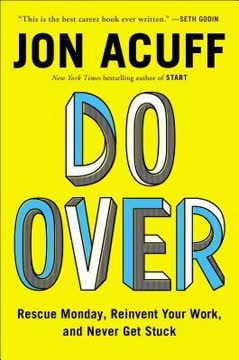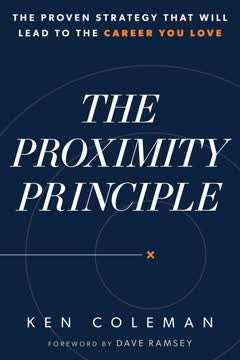Key Takeaways
1. Embrace the leap: Change is inevitable, so jump with courage
Every great story starts with a jump—a risk, leaping into the unknown, not knowing exactly how you will land.
Change is constant. Whether you're making a survival jump out of necessity, an opportunity jump to seize a new possibility, or a stagnant jump to break free from complacency, taking the leap is essential for growth and success. Embracing change requires courage, but it's the only way to truly transform your life and achieve your goals.
Preparation is key. While you can't control every outcome, you can prepare yourself mentally and logistically for the jump:
- Identify your motivations and desired outcomes
- Assess potential risks and rewards
- Develop a backup plan or safety net
- Gather support from trusted friends, family, or mentors
Remember, it's better to take an imperfect leap than to remain stagnant. The path forward often reveals itself only after you've taken that first courageous step.
2. Master your mindset: Confidence and visualization are key
Confidence is an active choice.
Cultivate confidence. Contrary to popular belief, confidence is not an innate trait but a skill that can be developed through practice and positive thinking. To build confidence:
- Celebrate small wins and accomplishments
- Practice positive self-talk and affirmations
- Seek out challenges that push you slightly out of your comfort zone
- Learn from failures and setbacks, viewing them as opportunities for growth
Harness visualization. Successful people across various fields use visualization techniques to achieve their goals. To effectively visualize success:
- Create a detailed mental image of your desired outcome
- Engage all your senses in the visualization process
- Practice visualization regularly, especially before important events or decisions
- Use vision boards or written goals to reinforce your mental images
By mastering your mindset through confidence-building and visualization, you'll be better equipped to overcome obstacles and achieve your goals.
3. Turn fears into fuel: Embrace discomfort for growth
Fear is a survival instinct inherited from early humankind. It is a signal that something is wrong that protects you from danger and allows you to survive.
Understand fear's purpose. Fear is a natural human emotion designed to protect us from danger. However, in modern life, our fears often hold us back from growth and success. Common fears include:
- Fear of failure
- Fear of uncertainty
- Fear of rejection
- Fear of not being good enough
- Fear of success
Transform fear into motivation. Instead of letting fear paralyze you, use it as fuel for action:
- Feel your fear: Acknowledge and accept your emotions
- Embrace your fear: Recognize it as a sign of growth and opportunity
- Act on your fear: Take small steps to confront and overcome it
- Repeat: Build resilience by consistently facing your fears
By reframing fear as a catalyst for growth, you can push through discomfort and achieve remarkable results.
4. Make decisive moves: Trust your gut and take calculated risks
Decisions are beginnings, not endings.
Trust your instincts. While thorough research and analysis are important, sometimes you need to rely on your gut feelings to make decisions. Trusting your intuition can lead to better outcomes, especially when:
- You have limited time to make a choice
- You're faced with complex or ambiguous situations
- You've developed expertise in a particular area
Take calculated risks. Successful decision-making often involves balancing intuition with careful consideration of potential outcomes:
- Gather relevant information and assess pros and cons
- Consider the potential impact on your long-term goals
- Be willing to act with incomplete information (aim for 70% readiness)
- Learn from both successes and failures to refine your decision-making skills
Remember that decisions are not permanent. Be prepared to adapt and pivot as circumstances change, viewing each decision as a stepping stone toward your ultimate goals.
5. Define success on your own terms: Align goals with personal values
Success is relative, personal, and always changing.
Redefine success. Society often equates success with wealth, prestige, or power. However, true success is deeply personal and should align with your core values and aspirations. To define success on your own terms:
- Reflect on what truly matters to you (e.g., family, creativity, impact)
- Consider multiple aspects of life (career, relationships, personal growth)
- Set goals that resonate with your authentic self
- Regularly reassess and adjust your definition as you evolve
Measure what matters. Once you've defined success for yourself, establish meaningful metrics to track your progress:
- Create a balance of quantitative and qualitative measures
- Focus on both outcomes (e.g., financial goals) and processes (e.g., daily habits)
- Celebrate small wins and milestones along the way
- Be willing to adjust your metrics as your priorities shift
By aligning your goals with your personal values and measuring what truly matters to you, you'll find greater fulfillment and motivation in your journey.
6. Create a one-year success plan: Set clear milestones and celebrate wins
A goal without a deadline is just a daydream.
Develop a structured plan. A well-crafted one-year success plan provides direction and momentum for your jump. To create an effective plan:
- Define your vision: Clearly articulate where you want to be in one year
- Set SMART goals: Specific, Measurable, Attainable, Relevant, and Time-bound
- Break down goals into actionable steps and milestones
- Assign deadlines to each step and milestone
- Identify potential obstacles and develop strategies to overcome them
Track progress and celebrate wins. Regularly monitoring your progress and acknowledging achievements keeps you motivated and on track:
- Review your plan weekly or monthly to assess progress
- Adjust goals and strategies as needed based on results and changing circumstances
- Celebrate small wins along the way to maintain momentum
- Use setbacks as learning opportunities to refine your approach
Remember that your one-year plan is a flexible roadmap, not a rigid schedule. Be prepared to adapt and pivot as you progress toward your ultimate vision.
7. Build strong relationships: Expand your network and find mentors
Life really is a team sport. Everything works better when you've got a squad to back you up.
Cultivate meaningful connections. Building a strong network is essential for personal and professional growth. To expand your network effectively:
- Focus on quality over quantity in relationships
- Attend industry events and join professional organizations
- Engage in online communities and social media platforms
- Offer value to others before seeking help or favors
Find mentors and advisors. Mentorship can accelerate your growth and provide valuable insights. To find and nurture mentorship relationships:
- Identify potential mentors in your field or area of interest
- Approach mentors with clear goals and respect for their time
- Be proactive in seeking advice and following through on recommendations
- Consider multiple mentors for different aspects of your life or career
Remember that networking and mentorship are two-way streets. Always look for opportunities to give back and support others in their journeys.
8. Tap into inner strength: Cultivate resilience and emotional courage
Perseverance is strength. Facing tough circumstances and not giving up is strength.
Develop resilience. The ability to bounce back from setbacks is crucial for long-term success. To build resilience:
- Cultivate a growth mindset, viewing challenges as opportunities to learn
- Practice self-compassion and positive self-talk
- Build a support network to lean on during difficult times
- Develop healthy coping mechanisms (e.g., exercise, meditation, journaling)
Foster emotional courage. Facing and embracing difficult emotions is key to personal growth and overcoming obstacles. To build emotional courage:
- Practice vulnerability by sharing your fears and struggles with trusted individuals
- Confront uncomfortable situations or conversations head-on
- Learn to sit with and process difficult emotions rather than avoiding them
- Regularly step out of your comfort zone in small ways
By tapping into your inner strength and cultivating resilience and emotional courage, you'll be better equipped to handle the challenges that come with taking a significant leap in your life or career.
9. Stop caring what others think: Focus on your own opinion and cut out critics
Everybody has an opinion—especially about what society deems as normal or not normal, what is good or bad, and what they think is right or wrong. But out of the trillions of opinions, the only opinion that really counts is your own.
Prioritize self-approval. Constantly seeking validation from others can hold you back from pursuing your true goals and desires. To focus on your own opinion:
- Clarify your personal values and priorities
- Practice making decisions based on your own judgment
- Learn to differentiate between constructive feedback and unhelpful criticism
- Celebrate your unique qualities and experiences
Manage negative influences. Surrounding yourself with supportive people is crucial for maintaining a positive mindset. To minimize the impact of critics:
- Conduct a "life audit" to identify energy-draining relationships
- Set boundaries with negative individuals, limiting your exposure to their criticism
- Seek out relationships with positive, supportive people who encourage your growth
- Remember that others' opinions often reflect their own insecurities and limitations
By focusing on your own opinion and surrounding yourself with supportive individuals, you'll gain the confidence and clarity needed to take bold leaps and pursue your dreams without hesitation.
Last updated:
FAQ
What’s "Jump: Dare to Do What Scares You in Business and Life" by Kim Perell about?
- Guide to Taking Leaps: The book is a practical guide for anyone looking to make bold changes in their business or personal life by taking calculated risks and embracing the unknown.
- Personal and Professional Growth: Kim Perell shares her own journey from being broke and unemployed to becoming a successful entrepreneur and investor, using her experiences to illustrate how to overcome fear and stagnation.
- Actionable Framework: The book provides step-by-step strategies, mindset shifts, and exercises to help readers identify their reasons for wanting change, prepare for their "jump," and execute it with confidence.
- Empowerment and Courage: At its core, the book is about empowering readers to trust themselves, face their fears, and pursue a more fulfilling and impactful life.
Why should I read "Jump: Dare to Do What Scares You in Business and Life" by Kim Perell?
- Real-World Experience: Kim Perell draws from over 20 years of entrepreneurial experience, sharing both her successes and failures to provide relatable, honest advice.
- Actionable Steps: The book is filled with practical exercises, "Jump Prep" checklists, and "Jump Hacks" to help readers move from intention to action.
- Universal Relevance: Whether you’re facing a career pivot, starting a business, or seeking personal growth, the book’s principles apply to a wide range of life changes.
- Inspiration and Motivation: Through stories of her own journey and those of others, Perell inspires readers to overcome fear, self-doubt, and external criticism.
What are the key takeaways from "Jump: Dare to Do What Scares You in Business and Life"?
- Three Types of Jumps: Understand the Survival Jump (forced by circumstances), Opportunity Jump (pursuing a vision), and Stagnant Jump (escaping stagnation).
- Mindset is Critical: Mastering your mindset, deleting excuses, and building confidence are foundational to making any significant change.
- Fear as Fuel: Rather than eliminating fear, learn to acknowledge, embrace, and use it as motivation for growth.
- Preparation and Action: Look before you leap by preparing backup plans, but don’t wait for perfect readiness—action and momentum are key.
What are the three types of "jumps" described in Kim Perell’s method in "Jump"?
- Survival Jump: Taken when you have no other choice, such as after a job loss or major life event; it’s reactive but can be transformative.
- Opportunity Jump: Made when you see a chance to improve your life or pursue a dream, even if you’re currently comfortable or successful.
- Stagnant Jump: Chosen when you feel stuck, bored, or unfulfilled, and realize that comfort is holding you back from growth.
- Key Insight: The reason for your jump matters less than having the courage to take it.
How does Kim Perell in "Jump" recommend overcoming fear and using it as fuel?
- Acknowledge and Name Fears: Identify specific fears such as failure, uncertainty, rejection, not being good enough, or even fear of success.
- FEAR Process: Use the four-step process—Feel, Embrace, Act, Repeat—to face and move through fear.
- Practice Discomfort: Regularly put yourself in uncomfortable situations to build resilience and confidence.
- Reframe Fear: Focus on loving your goal or vision more than you fear the obstacles, and use fear as a motivator rather than a barrier.
What mindset shifts does Kim Perell advocate for in "Jump: Dare to Do What Scares You in Business and Life"?
- Delete Excuses: Recognize and eliminate common excuses like lack of time, money, experience, or fear of failure.
- Visualize Success: Use visualization techniques and vision boards to keep your goals top-of-mind and activate your subconscious toward achievement.
- Build Confidence Through Action: Confidence is built by taking small steps and celebrating wins, not by waiting to feel ready.
- Accept Imperfection: Understand that you will never be 100% ready; progress and learning come from action, not perfection.
What practical steps does "Jump" by Kim Perell suggest for preparing to make a big change?
- Look Before You Leap: Assess risks, identify your strengths, and consider the impact on others before making a major move.
- Create a Backup Plan: Prepare for setbacks by having financial, logistical, and emotional safety nets in place.
- Start with Micro-Jumps: Build momentum and confidence by taking small, manageable risks leading up to your big jump.
- Answer Key Questions: Reflect on worst-case scenarios, who will be affected, and your first steps to ensure you’re making an informed decision.
How does Kim Perell define success in "Jump: Dare to Do What Scares You in Business and Life"?
- Personal Definition: Success is relative and personal, encompassing physical, emotional, spiritual, and financial well-being.
- Beyond Money and Titles: True success is not just about wealth or status, but about fulfillment, impact, and living according to your values.
- Clarify and Measure: Define what success looks like for you, set clear metrics, and track progress based on what matters most to you.
- Make Peace with the Past: Let go of old definitions and unresolved issues to fully embrace your new path.
What is the "One-Year Success Plan" in "Jump" and how do you create one?
- Vision-Driven Planning: Start by articulating a clear vision of where you want to be in one year, what you want to accomplish, and who you want to become.
- Reverse Engineering: Work backward from your goal to identify milestones, deadlines, and the hardest tasks to tackle first.
- SMART Goals: Set Specific, Measurable, Attainable, Relevant, and Timely goals, and break them into actionable steps.
- Accountability and Celebration: Find an accountability partner, integrate your plan into your daily routine, and celebrate small wins along the way.
What role do relationships and networking play in Kim Perell’s approach in "Jump"?
- No One Succeeds Alone: Building a supportive team, finding mentors, and expanding your network are essential for personal and professional growth.
- Deep Connections Over Quantity: Focus on cultivating meaningful, mutually beneficial relationships rather than superficial contacts.
- Give Without Expectation: Approach networking with a mindset of generosity, offering help and value without expecting immediate returns.
- Active Listening and Inclusivity: Practice active listening, be inclusive, and regularly audit your relationships to ensure they support your goals.
How does "Jump" by Kim Perell address dealing with criticism, people-pleasing, and caring what others think?
- Prioritize Your Own Opinion: Recognize that the only opinion that truly matters is your own, especially when making life-changing decisions.
- Limit Negative Influences: Perform a "life audit" to identify and distance yourself from critics, emotional vampires, and negative relationships.
- Resist People-Pleasing: Understand the dangers of sacrificing your own needs for others’ approval and learn to set healthy boundaries.
- Accentuate the Positive: Use gratitude journals, savor positive moments, and practice mindfulness to counteract negativity bias and external criticism.
What are the best quotes from "Jump: Dare to Do What Scares You in Business and Life" by Kim Perell and what do they mean?
- “You have to be different to make a difference.” – Emphasizes the importance of embracing your uniqueness and not conforming just to fit in.
- “You must do the thing you think you cannot do.” (Eleanor Roosevelt) – Encourages facing fears head-on as a path to growth and confidence.
- “The biggest risk a person can take is to do nothing.” (Robert Kiyosaki) – Highlights that inaction and stagnation are often riskier than taking bold steps.
- “A path leads to a path.” – Reminds readers that taking action, even if imperfect, opens up new opportunities and directions.
- “Feel the fear and do it anyway.” – The central message of the book: fear is natural, but it shouldn’t stop you from pursuing your dreams.
Review Summary
Jump received generally positive reviews, with readers praising its motivational content and practical advice for career changes and entrepreneurship. Many found the author's personal experiences and case studies inspiring. Readers appreciated the book's actionable tips, "jump prep" sections, and emphasis on overcoming fears. Some critics felt the information was generic or aimed at beginners. Overall, reviewers found the book helpful for those considering major life or career transitions, with particular value for aspiring entrepreneurs and recent graduates.
Similar Books










Download PDF
Download EPUB
.epub digital book format is ideal for reading ebooks on phones, tablets, and e-readers.





